Generate Spatially Consistent Statistical Channels for Realistic Simulations
What is spatial consistency
Spatial consistency in 3D wireless channel modeling refers to the predictability and stability of radio propagation characteristics across different spatial locations within a three-dimensional environment. In simpler terms, it’s about how the wireless channel behaves consistently in terms of signal strength, fading, and other properties as you move around in physical space. When modeling wireless channels in three dimensions, it’s essential to consider how the signal behaves not only in different locations but also in different directions (height, azimuth, and elevation angles). Spatial consistency helps researchers and engineers understand how the wireless signal propagates throughout a given area, allowing for more accurate predictions of signal coverage, quality, and reliability. In practical terms, spatial consistency means that if you move from one point to another within the modeled environment, you can expect similar channel characteristics, such as signal strength and fading statistics, assuming the environment remains unchanged. This consistency is crucial for designing and optimizing wireless communication systems, especially in scenarios like urban environments or indoor spaces where signal propagation can be complex and variable.
The tutorial covers the following:
The tutorial will demonstate the following features which are expected characteristics of wireless channels:
Power variation accross the time and space.
Spatial distribution of LoS/NLoS links.
Doppler characteristics accross time and space.
Multipath delay variation accross time and space.
Import Libraries
Import Python Libraries
[1]:
import os
os.environ["CUDA_VISIBLE_DEVICES"] = "-1"
os.environ['TF_CPP_MIN_LOG_LEVEL'] = '3'
# %matplotlib widget
import matplotlib.pyplot as plt
import matplotlib.patches as patches
import matplotlib.animation as animation
import numpy as np
Import 5G Toolkit
[2]:
# importing necessary modules for simulating channel model
import sys
sys.path.append("../../../")
from toolkit5G.ChannelModels import NodeMobility
from toolkit5G.ChannelModels import AntennaArrays
from toolkit5G.ChannelModels import SimulationLayout
[3]:
# from IPython.display import display, HTML
# display(HTML("<style>.container { width:60% !important; }</style>"))
Simulation Parameters
Define the following Simulation Parameters:
propTerraindefines propagation terrain for BS-UE linkscarrierFrequencydefines carrier frequency in HznBSsdefines number of Base Stations (BSs)nUEsdefines number of User Equipments (UEs)nSnapShotsdefines number of SnapShots, where SnapShots correspond to different time-instants at which a mobile user channel is being generated.
[4]:
# Simulation Parameters
propTerrain = "UMa" # Propagation Scenario or Terrain for BS-UE links
carrierFrequency = 3*10**9 # carrier frequency in Hz
nBSs = 3 # number of BSs
nUEs = 1 # number of UEs
nSnapShots = 64 # number of SnapShots
Antenna Arrays
Antenna Array at Rx
The following steps describe the procedure to generate AntennaArrays Objects at a single carrier frequency both at Tx and Rx side:
Choose an omni directional dipole antenna for Rx, for which we have to pass the string “OMNI” while instantiating
AntennaArraysclass.Pass
arrayStructureof[1,1,2,2,1]meaning 1 panel in vertical direction, 1 panel in horizonatal direction, 2 antenna elements per column per panel, 2 columns per panel and 1 correspond to antenna element being single polarized.For this antenna structure, the number of Rx antennas
Nrto be 4.
[5]:
# Antenna Array at UE side
# antenna element type to be "OMNI"
# with single panel and 4 single polarized antenna element per panel.
ueAntArray = AntennaArrays(antennaType = "OMNI",
centerFrequency = carrierFrequency,
arrayStructure = np.array([1,1,2,2,1]))
ueAntArray()
# num of Rx antenna elements
nr = ueAntArray.numAntennas
# Radiation Pattern of Rx antenna element
fig, ax = ueAntArray.displayAntennaRadiationPattern()
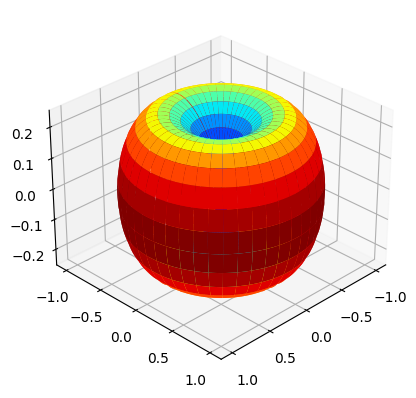
Antenna Array at Tx
We choose a parabolic antenna for Tx, for which we have to pass the string
"3GPP_38.901"while instantiatingAntennaArraysclass.We pass
arrayStructureof[1,1,2,4,2]meaning 1 panel in vertical direction, 1 panel in horizonatal direction, 2 antenna elements per column per panel, 4 columns per panel and 2 correspond to antenna element being dual polarized.With this structure, we obtain number of Tx antennas
ntto be 16.
[6]:
# Antenna Array at BS side
# antenna element type to be "3GPP_38.901", a parabolic antenna
# with single panel and 8 dual polarized antenna element per panel.
bsAntArray = AntennaArrays(antennaType = "3GPP_38.901",
centerFrequency = carrierFrequency,
arrayStructure = np.array([1,1,2,4,2]))
bsAntArray()
# num of Tx antenna elements
nt = bsAntArray.numAntennas
# Radiation Pattern of Tx antenna element
fig, ax = bsAntArray.displayAntennaRadiationPattern()

Node Mobility
Generate the route/trajectory for the mobile UE:
All the Base Stations (BSs) are considered to be static and the User Equipments (UE) is mobile.
The UE is moving at 0.833 m/s (3 kmph) on a circular trajectory of radius 250 meter centered around origin.
For the UE, 60 snapshots are drawn while in motion on the circle with an interval of 5 sec.
The parameters are selected such that the UE complete the circumference of the circle.
[7]:
# NodeMobility parameters
# assuming that all the BSs are static and all the UEs are mobile.
# time values at each snapshot.
isInitLocationRandom = True # Initial location of the UE is random.
initAngle = None # Not required when isInitLocationRandom is True.
isInitOrientationRandom = False # UE Orientations are UE. Not randomized.
snapshotInterval = (0.5*10**-3)/14 # 5 second
speed = 0.833 # speed of the UE 3 Kmph
radius = 250 # 3 Kmph
timeInst = snapshotInterval*np.arange(nSnapShots, dtype=np.float32)
UEroute = NodeMobility("circular", nUEs, timeInst, radius, radius,
speed, speed, isInitLocationRandom, initAngle,
isInitOrientationRandom)
UEroute()
fig, ax = UEroute.displayRoute()
ax.set_aspect(True)

Simulation Layout
We define the simulation topology parametes:
ISD: Inter Site DistanceminDist: Minimum distance between transmitter and receiver.bsHt: BS heightsueHt: UE heightstopology: Simulation TopologynSectorsPerSite: Number of Sectors Per Site
Furthermore, users can access and update following parameters as per their requirements for channel using the handle simLayoutObj.x where x is:
The following parameters can be accessed or updated immendiately after object creation
UEtracksUELocationsueOrientationUEvelocityVectorBStracksBSLocationsbsOrientationBSvelocityVector
The following parameters can be accessed or updated after calling the object
linkStateVec
[8]:
# Layout Parameters
isd = 500 # inter site distance
minDist = 35 # min distance between each UE and BS
ueHt = 1.5 # UE height
bsHt = 35 # BS height
topology = "Hexagonal" # BS layout type
nSectorsPerSite = 3 # number of sectors per site
memoryEfficient = False
enableSpatialConsistencyLoS = True
enableSpatialConsistencyIndoor = True
print(" enableSpatialConsistency: "+str(enableSpatialConsistencyLoS))
print(" memoryEfficient: "+str(memoryEfficient))
print("enableSpatialConsistencyIndoor: "+str(enableSpatialConsistencyIndoor))
# simulation layout object
simLayoutObj = SimulationLayout(numOfBS = nBSs,
numOfUE = nUEs,
heightOfBS = bsHt,
heightOfUE = ueHt,
ISD = isd,
layoutType = topology,
numOfSectorsPerSite = nSectorsPerSite,
ueRoute = UEroute,
memoryEfficient = memoryEfficient,
enableSpatialConsistencyLoS = enableSpatialConsistencyLoS,
enableSpatialConsistencyIndoor = enableSpatialConsistencyIndoor)
# Update UE location for motion over a circle centered around the BS location.
# simLayoutObj.UELocations = -simLayoutObj.UEtracks.mean(0)
simLayoutObj(terrain = propTerrain,
carrierFreq = carrierFrequency,
ueAntennaArray = ueAntArray,
bsAntennaArray = bsAntArray,
forceLOS = False)
# displaying the topology of simulation layout
fig, ax = simLayoutObj.display2DTopology()
ax.scatter(simLayoutObj.UELocations[0,0]+simLayoutObj.UEtracks[:,0,0],
simLayoutObj.UELocations[0,1]+simLayoutObj.UEtracks[:,0,1],
color="k", label = "NLoS Instants", zorder=-1)
ax.scatter(simLayoutObj.UELocations[0,0]+simLayoutObj.UEtracks[simLayoutObj.linkState[:,0,3],0,0],
simLayoutObj.UELocations[0,1]+simLayoutObj.UEtracks[simLayoutObj.linkState[:,0,3],0,1],
color="r", label = "LoS Instants", zorder=-1)
ax.scatter(simLayoutObj.UELocations[0,0],simLayoutObj.UELocations[0,1], color="b", label = "UE-InitialLocation", zorder=-3)
ax.set_xlabel("x-coordinates (m)")
ax.set_ylabel("y-coordinates (m)")
ax.set_title("Simulation Topology")
ax.legend()
# plt.show()
enableSpatialConsistency: True
memoryEfficient: False
enableSpatialConsistencyIndoor: True
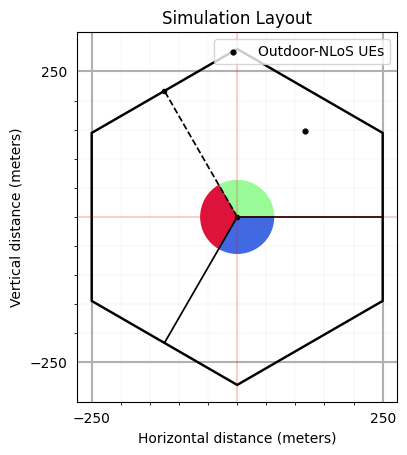
[8]:
<matplotlib.legend.Legend at 0x7fca11a9ef10>
Channel Parameters, Channel Coefficients and OFDM Channel
The user can access the channel coefficents and other parameters using following handles:
LSPs/SSPs: paramGenObj.x where x is
linkStateVecdelaySpreadphiAoA_LoS,phiAoA_mn,phiAoA_spreadthetaAoA_LoS,thetaAoA_mn,thetaAoA_spreadphiAoD_LoS,phiAoD_mn,phiAoD_spreadthetaAoD_LoS,thetaAoD_mn,thetaAoD_spreadxprpathloss,pathDelay,pathPowershadowFading
Channel Co-efficeints: channel.x where x is
coefficientsdelays
Shape of OFDM Channel:
Hfis of shape :(number of carrier frequencies, number of snapshots, number of BSs, number of UEs, Nfft, number of Rx antennas, number of Tx antennas)
[9]:
# Generate SSPs/LSPs Parameters:
paramGenObj = simLayoutObj.getParameterGenerator(memoryEfficient = True,
enableSpatialConsistencyForLSPs = True,
enableSpatialConsistencyForSSPs = True,
enableSpatialConsistencyForInitialPhases = True)
# Generate Channel Coefficeints and Delays: SSPs/LSPs
channel = paramGenObj.getChannel(applyPathLoss = True)
# Channel coefficients can be accessed using: channel.coefficients
# Channel delays can be accessed using: channel.delays
# Generate OFDM Channel
Nfft = 2048
Hf = channel.ofdm(30*10**3, Nfft, simLayoutObj.carrierFrequency)
[Warning]: Pathloss model for UMa is defined only for BS height 'hBS' = 25! Ignoring for now but might results in unexpected behaviour!
[Warning]: UE height 'hUE' cannot be less than 1.5! These values are forced to 1.5! for 'UMa'
[10]:
fig, ax = paramGenObj.displayClusters(indices=(0, 1, 0), rayIndex=1, carrierIndex=0,
radiusRx=10, radiusTx=10, displayPlot=False)
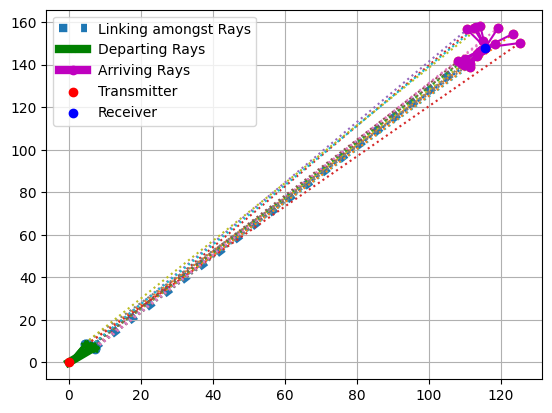
Frequency Domain Consistency
[11]:
Hf.shape
[11]:
(1, 64, 3, 1, 2048, 4, 16)
Amplitude Spectrum: Each subcarrier accross time
[12]:
fig, ax = plt.subplots(2,1, figsize = (11,5.5))
carrierIndex = 0
bsIndex = 0
ueIndex = 0
bsAntIndex = 0
ueAntIndex = 0
for snap in range(3):
ax[0].plot(np.abs(Hf[carrierIndex,snap,bsIndex,ueIndex,:,bsAntIndex,ueAntIndex]), label="Symbol-Index: "+str(snap))
ax[0].legend()
ax[0].grid(color='c', linestyle='-', linewidth=1)
ax[0].set_xlabel("Subcarrier Indices")
ax[0].set_ylabel("Amplitude")
for snap in range(3):
ax[1].plot(np.angle(Hf[carrierIndex,snap,bsIndex,ueIndex,:,bsAntIndex,ueAntIndex]), label="Symbol-Index: "+str(snap))
# ax[1].plot(np.unwrap(np.angle(Hf[carrierIndex,snap,bsIndex,ueIndex,:,bsAntIndex,ueAntIndex])), label="Symbol-Index: "+str(snap))
ax[1].legend()
ax[1].grid(color='c', linestyle='-', linewidth=1)
ax[1].set_xlabel("Subcarrier Indices")
ax[1].set_ylabel("Phase")
# Gridlines based on minor ticks
plt.show()
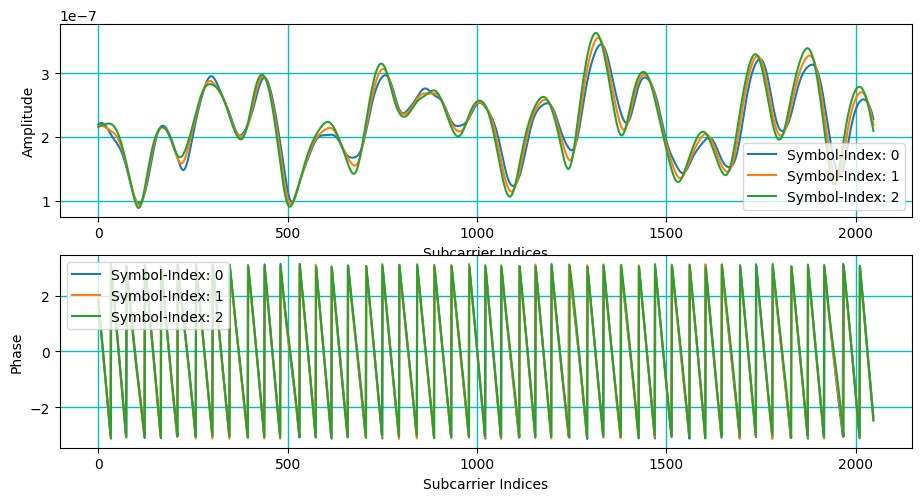
Amplitude Spectrum: One subcarrier accross time
[13]:
fig, ax = plt.subplots(figsize = (11,5.5))
carrierIndex = 0
bsIndex = 0
ueIndex = 0
bsAntIndex = 0
ueAntIndex = 0
for sc in range(0,300,60):
ax.plot(10*np.log10(np.abs(Hf[carrierIndex,:,bsIndex,ueIndex,sc,bsAntIndex,ueAntIndex])), label="Subcarrier-Index: "+str(sc))
ax.legend()
ax.grid(color='c', linestyle='-', linewidth=1)
ax.set_xlabel("OFDM Symbol Indices (n)")
ax.set_ylabel("Amplitude (dB)")
ax.set_title("Amplitude Variation across time for different subcarriers")
# Gridlines based on minor ticks
plt.show()
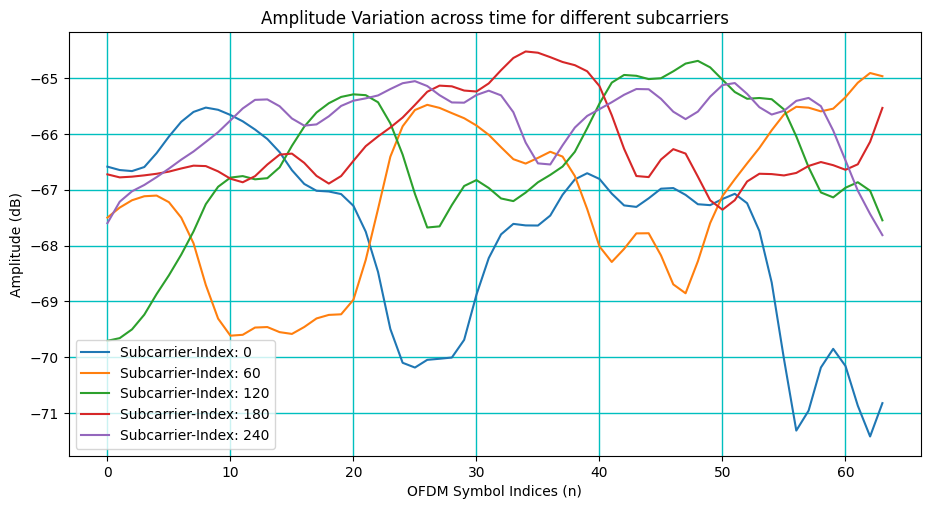
[14]:
fig, ax = plt.subplots(figsize = (11,5.5))
carrierIndex = 0
bsIndex = 0
ueIndex = 0
bsAntIndex = 0
ueAntIndex = 0
for sc in range(0,300,60):
ax.plot(np.unwrap(np.angle(Hf[carrierIndex,:,bsIndex,ueIndex,sc,bsAntIndex,ueAntIndex])), label="Subcarrier-Index: "+str(sc))
ax.legend()
ax.grid(color='c', linestyle='-', linewidth=1)
ax.set_xlabel("Subcarrier Indices")
ax.set_ylabel("Unwrapped Phase")
ax.set_title("Phase Variation across time for different subcarriers")
# Gridlines based on minor ticks
plt.show()
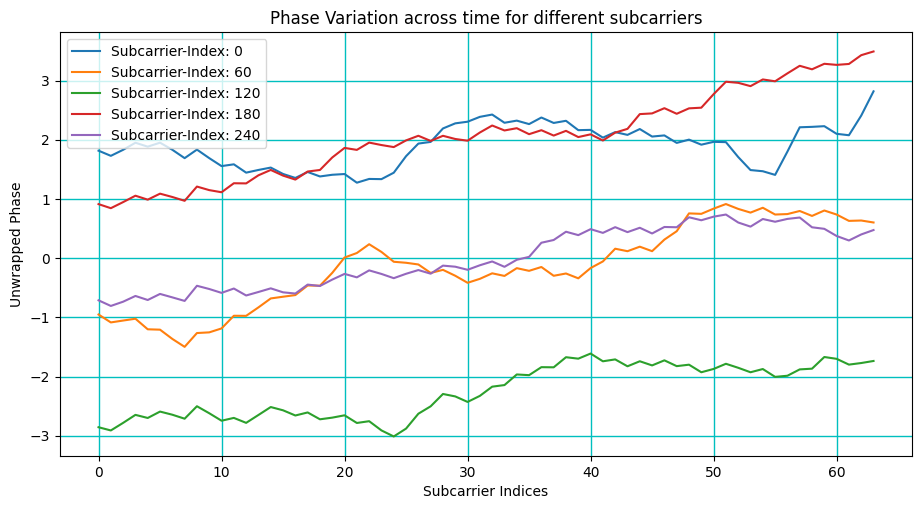
Amplitude Heatmap
[15]:
fig, ax = plt.subplots(figsize = (11,5.5))
carrierIndex = 0
bsIndex = 0
ueIndex = 0
bsAntIndex = 0
ueAntIndex = 0
ax.imshow(10*np.log10(np.abs(Hf[carrierIndex,:,bsIndex,ueIndex,:,bsAntIndex,ueAntIndex])), cmap = 'hot', interpolation='nearest', aspect = "auto")
ax = plt.gca();
ax.grid(color='c', linestyle='-', linewidth=1)
ax.set_xlabel("Subcarrier Indices")
ax.set_ylabel("Time Domain OFDM Symbol Inidces")
ax.set_title("Heatmap of the amplitude (dB)")
# Gridlines based on minor ticks
plt.show()

Phase Spectrum
[16]:
fig, ax = plt.subplots(figsize = (11,5.5))
carrierIndex = 0
bsIndex = 0
ueIndex = 0
bsAntIndex = 0
ueAntIndex = 0
ax.imshow(np.unwrap(np.angle(Hf[carrierIndex,:,bsIndex,ueIndex,:,bsAntIndex,ueAntIndex])), cmap = 'hot', interpolation='nearest', aspect = "auto")
ax = plt.gca();
ax.grid(color='c', linestyle='-', linewidth=1)
ax.set_xlabel("Subcarrier Indices")
ax.set_ylabel("Time Domain OFDM Symbol Inidces")
ax.set_title("Heatmap of the unwraped phase (dB)")
# Gridlines based on minor ticks
plt.show()
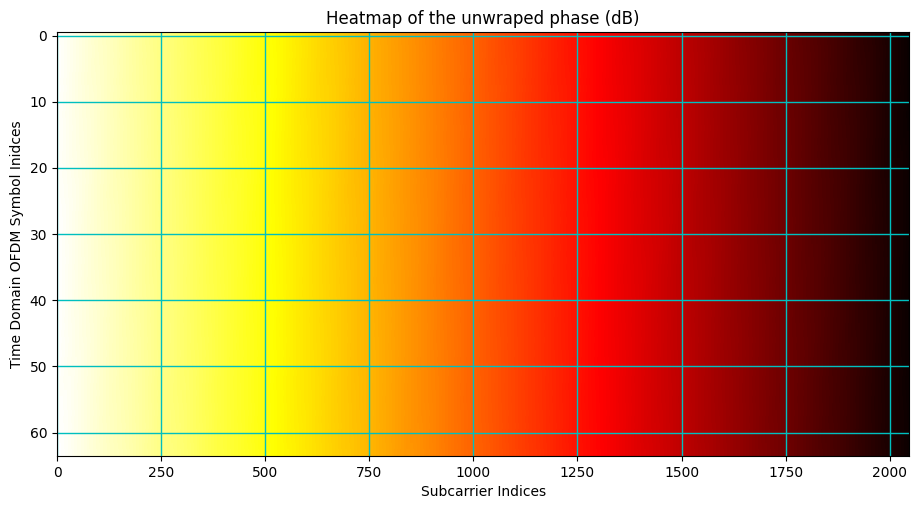
Doppler Domain Sparsity
[17]:
ht = np.fft.ifft(Hf, n = Nfft, axis=-3)
hDoppler = np.fft.ifft(ht, n = nSnapShots, axis=1)
[18]:
fig, ax = plt.subplots(figsize = (11,5.5))
carrierIndex = 0
snapIndex = 0
bsIndex = 0
ueIndex = 0
bsAntIndex = 0
ueAntIndex = 0
# ax.stem(channel.delays[carrierIndex,snapIndex,bsIndex,ueIndex], np.abs(channel.coefficients[carrierIndex,snapIndex,bsIndex,ueIndex,:,ueAntIndex,bsAntIndex]), "r", label = "Ideal Channel")
ax.stem(np.arange(nSnapShots)/(nSnapShots*0.5*10**-3), np.abs(hDoppler[carrierIndex,:,bsIndex,ueIndex,2,ueAntIndex,bsAntIndex]), "g", label = "Practical Channel")
ax.legend()
# ax.set_xlim([0, 0.25*10**-5])
ax.set_xlabel("Doppler Grid Indices (Hz)")
ax.set_ylabel("Power")
ax.grid()
plt.show()
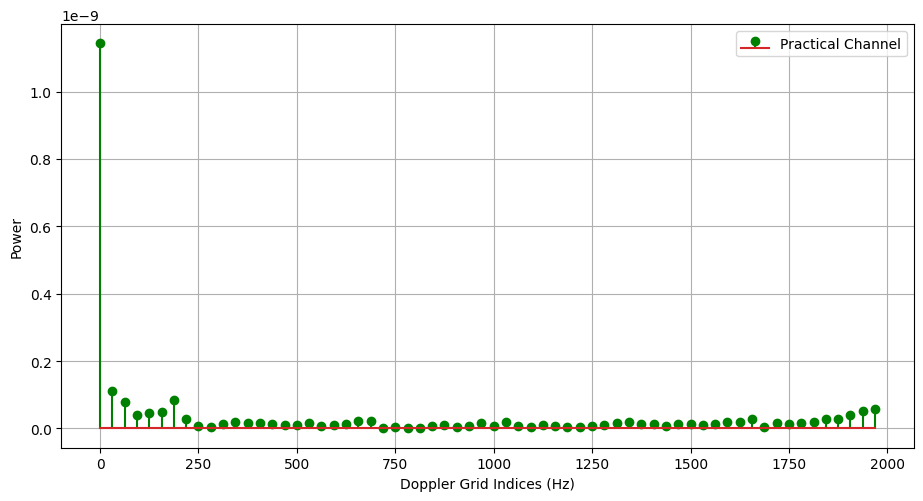
[19]:
fig, ax = plt.subplots(figsize = (11,5.5))
carrierIndex = 0
bsIndex = 0
ueIndex = 0
bsAntIndex = 0
ueAntIndex = 0
ax.imshow(10*np.log10(np.abs(hDoppler[carrierIndex,:,bsIndex,ueIndex,:,bsAntIndex,ueAntIndex])), cmap = 'hot', interpolation='nearest', aspect = "auto")
ax = plt.gca();
ax.grid(color='c', linestyle='-', linewidth=1)
ax.set_xlabel("Delays Indices")
ax.set_ylabel("Doppler Indices")
# Gridlines based on minor ticks
plt.show()
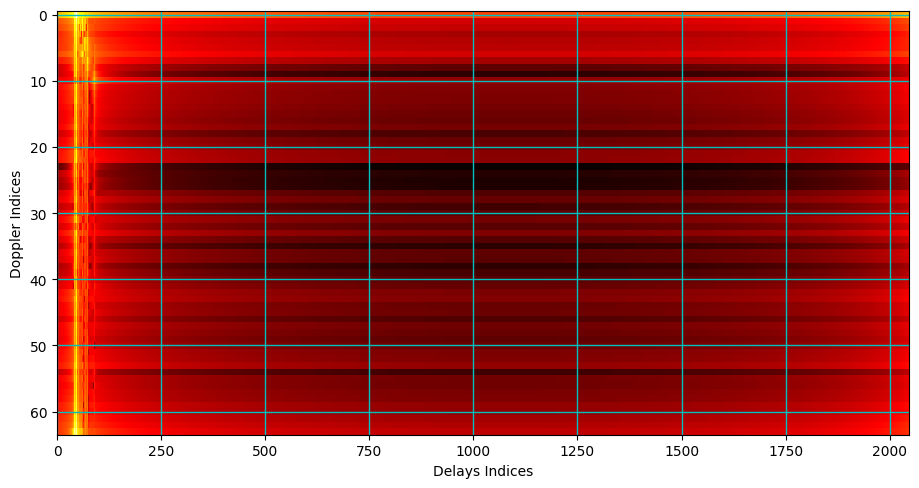
Delay/Time Domain: Sparsity
[20]:
fig, ax = plt.subplots(2,2,figsize = (11,8))
carrierIndex = 0
snapIndex = 0
bsIndex = 0
ueIndex = 0
bsAntIndex = 0
ueAntIndex = 0
tau0 = channel.delays[carrierIndex,snapIndex,bsIndex,ueIndex,1]
ax[0,0].stem(channel.delays[carrierIndex,snapIndex,bsIndex,ueIndex], np.abs(channel.coefficients[carrierIndex,snapIndex,bsIndex,ueIndex,:,ueAntIndex,bsAntIndex]), "r", label = "Ideal Channel")
ax[0,0].stem(np.arange(Nfft)/(Nfft*channel.subCarrierSpacing), np.abs(ht[carrierIndex,snapIndex,bsIndex,ueIndex,:,ueAntIndex,bsAntIndex]), "g", label = "Practical Channel")
ax[0,0].legend()
ax[0,0].set_xlim([0, 0.25*10**-5])
ax[0,0].set_xlabel("delays (s)")
ax[0,0].set_ylabel("Power")
ax[0,0].grid()
ax[0,1].stem(channel.delays[carrierIndex,snapIndex,bsIndex,ueIndex], np.abs(channel.coefficients[carrierIndex,snapIndex,bsIndex,ueIndex,:,ueAntIndex,bsAntIndex]), "r", label = "Ideal Channel")
ax[0,1].stem(np.arange(Nfft)/(Nfft*channel.subCarrierSpacing), np.abs(ht[carrierIndex,snapIndex,bsIndex,ueIndex,:,ueAntIndex,bsAntIndex]), "g", label = "Practical Channel")
ax[0,1].legend()
ax[0,1].set_xlim([0.9999*tau0, 1.0001*tau0])
ax[0,1].set_xlabel("delays (s)")
ax[0,1].set_ylabel("Power")
ax[0,1].grid()
snapIndex = 13
ax[1,0].stem(channel.delays[carrierIndex,snapIndex,bsIndex,ueIndex], np.abs(channel.coefficients[carrierIndex,snapIndex,bsIndex,ueIndex,:,ueAntIndex,bsAntIndex]), "r", label = "Ideal Channel")
ax[1,0].stem(np.arange(Nfft)/(Nfft*channel.subCarrierSpacing), np.abs(ht[carrierIndex,snapIndex,bsIndex,ueIndex,:,ueAntIndex,bsAntIndex]), "g", label = "Practical Channel")
ax[1,0].legend()
ax[1,0].set_xlim([0, 0.25*10**-5])
ax[1,0].set_xlabel("delays (s)")
ax[1,0].set_ylabel("Power")
ax[1,0].grid()
ax[1,1].stem(channel.delays[carrierIndex,snapIndex,bsIndex,ueIndex], np.abs(channel.coefficients[carrierIndex,snapIndex,bsIndex,ueIndex,:,ueAntIndex,bsAntIndex]), "r", label = "Ideal Channel")
ax[1,1].stem(np.arange(Nfft)/(Nfft*channel.subCarrierSpacing), np.abs(ht[carrierIndex,snapIndex,bsIndex,ueIndex,:,ueAntIndex,bsAntIndex]), "g", label = "Practical Channel")
ax[1,1].legend()
ax[1,1].set_xlabel("delays (s)")
ax[1,1].set_ylabel("Power")
ax[1,1].grid()
ax[1,1].set_xlim([0.9999*tau0, 1.0001*tau0])
fig.suptitle("Power Delay Profile for the Different Carrier Frequencies")
plt.show()
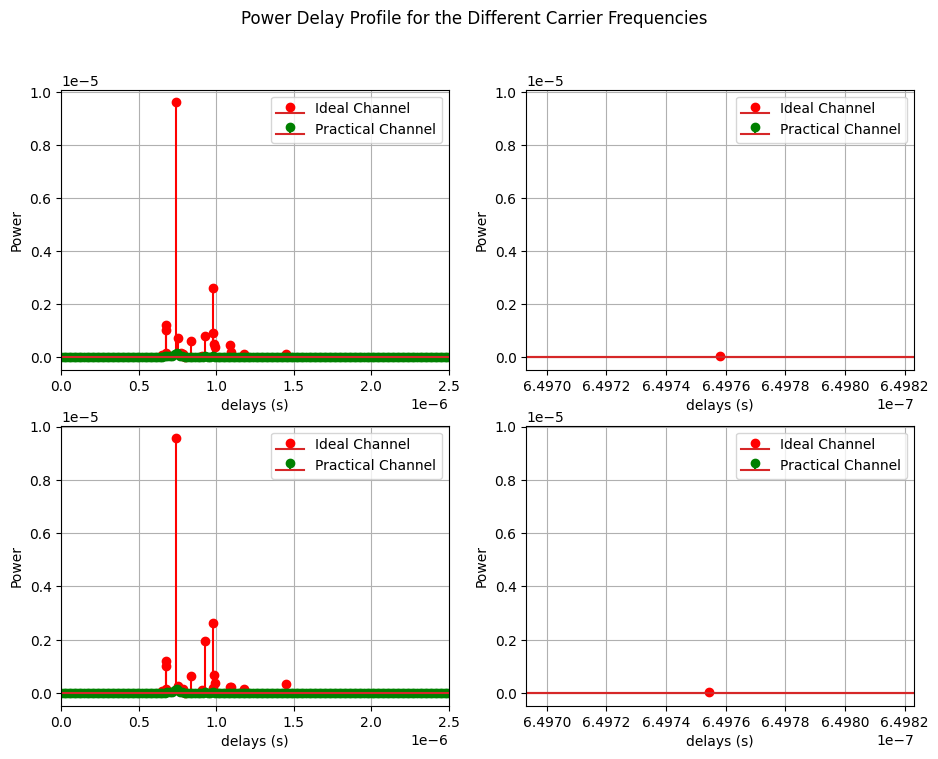
[ ]: